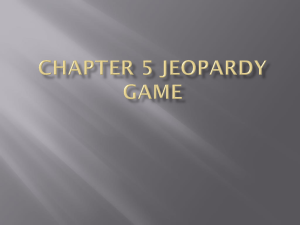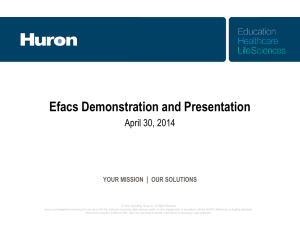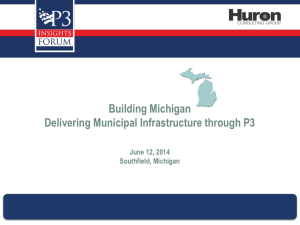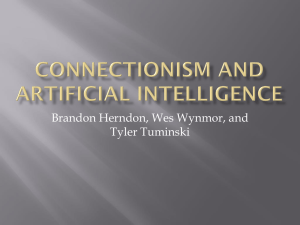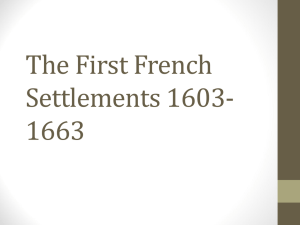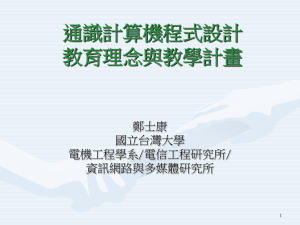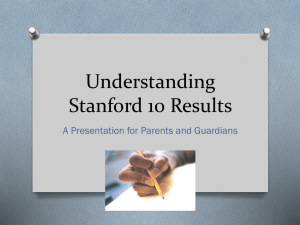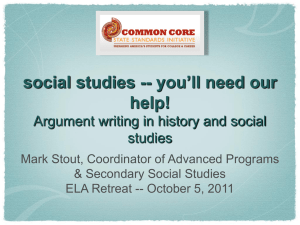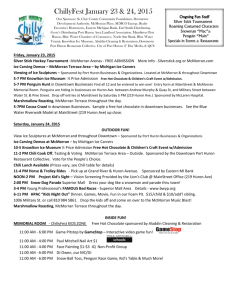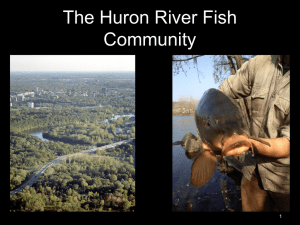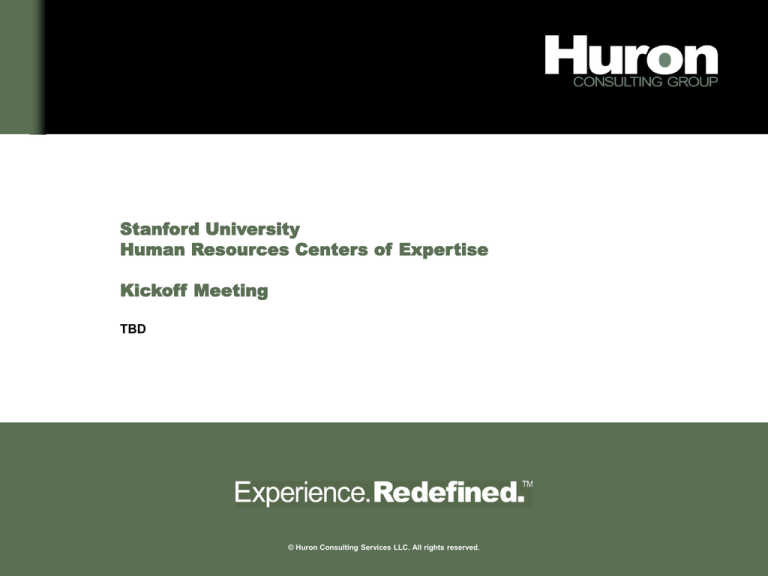
Stanford University
Human Resources Centers of Expertise
Kickoff Meeting
TBD
1
© Huron Consulting Services LLC. All rights reserved.
Agenda
Huron is pleased to work with Stanford University to develop strategies for creating HR
Centers of Expertise to improve Human Resources related services and support.
The objective of this document is to:
Outline our preliminary understanding of engagement objectives
Provide an overview of Huron’s approach
Provide an overview of our work plan
Introduce the Huron team members
Discuss critical issues and dependencies
– Key stakeholders and constituents
– Communications (pre and post project)
– Availability of data and other information
2
Engagement Objective
Huron will further assess Stanford’s current approach in delivering HR services and develop
recommendations to create HR Centers of Expertise.
Objectives:
To develop the concept and strategy for three HR Centers of Expertise and achieve operational excellence through
robust and centralized services and support.
Transaction and Records Management
Employee Relations
Recruiting and Staffing Support
Stanford HR Task Force Recommendations
1. Create “Centers of Expertise” to handle core HR activities (Transaction and Records Management, Employee Relations,
Recruiting and Staffing Support, and Job Evaluation and Classification),
2. Shift the HR manager role to strategic partner,
3. Improve the quality of supervisors and flattening the organization,
4. Develop a strategy to improve communications from HR to non-HR staff,
5. Simplify and facilitate the employee management process, and
6. Create more focus on employee development and succession planning.
Note: Job Evaluation and Classification to be completed by Towers Watson, as part of a larger compensation project,
and will be integrated with the three Centers of Expertise, under the direction of central HR.
3
Huron will leverage the HR Task Force report, along with the implementation challenges identified, to
develop implementation strategies.
Example Human Resources Processes
Building on our previous HR experience, and focusing on the identified three centers, we
have identified the following HR functions, that are typical areas for focus.
Sample HR Processes
Recruiting and Staffing Support
Transaction and Records Management
Creating effective method to identify
qualified candidates
Communicating standard and annual
policies and procedures
Optimizing utilization of current ERP
system
Maintaining up to date candidates pool
for campus wide recruiting needs
Negotiating with collective bargaining
units
Establishing advertising and marketing
recruitment plan
Interpreting collective bargaining
agreements
Developing common and integrated
information systems across HR
departments
Configuring job opening template
Resolving disputes
Configuring interview template
Providing employee termination support
Establishing screening criteria
Providing grievance counseling
Standardized hiring procedures
Providing arbitration support
Designing effective on-boarding
procedures for new employees
Administering Unemployment claims
Maintaining consistent and up to date
employee verification procedures
Ensuring compliance to State and
Federal hiring standards
4
Employee Relations
Managing formal complaint responses
Establishing performance evaluation and
metrics
Ensuring data consistency across
campus
Authorizing access to available HR data
Automating manual processes
Standardizing transactional processes
Document preservation
Enforcing privacy policies
Creating and distributing systematic
performance metrics and reports
Policies enforcement
We will work with the Steering Committee and subject matter experts to identify key areas of focus that are
critical to Stanford.
Example Human Resources Organizational Issues
Through our data analysis and interviews, we will identify critical campus-wide HR issues
specific to Stanford, with which we will use to build our recommendations.
Sample Critical Target Concerns:
1
People
4
Organization structure
Lack of training
Ambiguous authority
Ambiguous roles &
responsibilities /
accountability
Distributed responsibility
Lack of accountability
Lack of appropriate skill sets
2
5
Technology
Unnecessary manual
processes
Existing technology not
optimized
3
Metrics
Reporting & metrics
availability
5
Process
Lack of consistency
Different or lack of central
vs. local policies and
procedures
Lack of focus on customer
service
Reactive operating
approaches
Stanford’s Executive team will play a pivotal role in setting the tone at the top and enabling behavioral
change throughout the University.
Human Resources Process Mapping
Huron will utilize process mapping, whenever appropriate, to identify areas of
inefficiency or redundancy.
Illustrative
Transaction and Records
Management
Job
Evaluation
and
Classification*
Stanford
Human
Resources
Employee
Relations
Recruiting and Staffing
Support
* Not included in Huron’s scope of work, but will be integrated with other Centers of Expertise, under the direction of central HR.
6
We will work to determine processes within the three core areas, how these processes overlap, and to
determine the current balance of a given key process between central HR and other units and schools.
Huron’s Approach
Huron’s approach is designed to provide Stanford a detailed understanding of current HR
services and recommend changes to improve overall service level.
Document and
Evaluate Current
State
PreEngagement
Send data request
documents
Schedule interviews
Draft preliminary
project plan
7
Develop and
Validate
Recommendations
Document and vet
recommendations to
include organizational
Obtain an understanding of
structure, processes,
Identify unique and
current state of the HR
tasks, activities,
common HR service
function: organizational
transactions, and
requirements across the
structure, processes,
performance metrics
university
tasks, activities,
Prioritize
transactions, and
Understand software
recommendations,
performance metrics
capabilities both
including timeline,
centrally and at local
Develop current state HR
resource needs and
units and schools
process maps, as
identified challenges and
necessary
risks
Review budgets and
spending, if available
Validate understandings
Quantify the benefits and
with subject matter experts
define expectations of the
Extract and recommend
various changes
new standard business
Identify process
processes governing
breakdowns and
Evaluate alternative
work flow between units
inefficiencies
operating models
and the centers
/processes and
Revise and finalize project
organizational structures
plan
Conduct interviews and
Confirm Project
Scope and Objectives inventory all HR services
Jointly define criteria
that will be used to
measure the project’s
success
Perform Data
Analysis
Evaluate the efficiency
and effectiveness of
services
Deliver Final
Recommendations
Assist in delivering the
change management and
communication efforts
required for each center
Articulate the benefits and
expectations of changes to
affected departments, units,
and schools
Assist in the development of
a high-level implementation
plan for each of the centers
including organization
structures, staff required,
broad job descriptions, and
timelines
Assist with the development
of the governance model for
the Center of Expertise
Assist in developing servicelevel agreements
Our approach encompasses the detailed steps required to understand the current operations, and to build
implementation recommendations for each center.
Preliminary Project Work-plan
This 12 week project plan provides an overview of Huron’s approach and will likely
evolve as the team obtains a deeper understanding of the HR related activities.
Key Activities
Pre-Engagement
• Confirm our understanding of the project’s objectives and
jointly define criteria that will be used to measure the project’s
success
• Send data request documents and schedule interviews
Documents and Evaluate Current State
• Kick-off meeting
• Conduct Interviews
• Reviewing HR Task Force report to identify areas of focus
• Gather and review HR related financial and operational data
• Draft current process flow charts, if necessary
• Gain added insight into Stanford’s current operations to be
used as a foundation for developing functional assessments
and recommendations
• Finalize project plan
Perform Data Analysis and Conduct Additional Interviews
• Assess the current state of HR support and services, to
provide an understanding of service efficiencies, technical
architecture, organizational structure, resource allocation, and
employee skill sets
• Identify major areas of potential performance improvement
and associated enablers
Develop and Validate Recommendations
• Document and vet final recommendations to include
organizational structure, processes, tasks, activities,
transactions, and performance metrics
• Prepare findings and potential recommendations and gain
consensus
8
Deliver Final Recommendations
• Deliver final business cases and recommendations
• Deliver the change management and communication efforts
including potential governance models required for each
center
Weeks 1-2
Weeks 3-4
Weeks 5-6
Weeks 7-8
Weeks 9-10
Weeks 11-12
Steering Committee Meeting
Huron Deliverable
Illustrative
Sample Project Update Template
A project plan will be utilized to track accomplishments and issues as well as
communicate interim findings to the Steering Committee.
Project
HR Center of Expertise
Primary
Objective
To evaluate integrating all Stanford HR
functions into a centralized location.
Project Plan
Project
Activities
Documents and
Evaluate Current
State
Week Beginning
09-20
09-27
10-04
10-11
Date
September 29, 2010
Resource
Advisory Team
(Core)
John Doe
Joe Doe
Jane Doe
Conducted 4 interviews
Confirmed project scope
Key Activities
Held kick-off meeting with the
steering committee
Critical
Dependencies
Cooperation from local HR
departments
10-18
Accomplishments
for the Week
Perform Data
Analysis and
Conduct
Additional
Interviews
Develop and
Validate
Recommendations
Deliver Final
Recommendations
9
Engagement Team Overview
John Curry (Managing Director)
John will have overall responsibility for the project. John has worked with Huron for almost five years leading projects ranging from incentive-based
budgeting, to rationalization of complex IT organizations and library systems, to cost reductions through benchmark analysis and shared services,
among many others. Prior to joining Huron, John was Executive Vice President of MIT. Prior roles were: Vice President for Business and Finance at
Caltech, Administrative Vice Chancellor and CFO at UCLA, and Vice President for Budget and Planning at USC. His last three positions included
responsibility for Human Resources.
Loren Mann (Director)
Loren will serve as Project Director to ensure product quality as well as provide oversight for fieldwork and analysis. Loren has more than ten years
of experience with Higher Education and Non-Profit organizations and has focused primarily with organizational design, operating and capital budget
development, strategic analysis and planning, business case development, and financial due diligence. Most recently, he has worked with a large
public university with the organizational design and development of their Human Resources department and a large private university in the
organizational design and development of their Finance department. Loren holds a Master of Business Administration from the Harvard Business
School, a Master of Science in Mechanical Engineering from Rensselaer Polytechnic Institute, and a Bachelor of Science in Mechanical Engineering
from the University of Illinois at Champaign-Urbana.
Alan Chen (Manager)
Alan has 8 years of experience in providing consulting and business advisory services to universities, hospitals, mission-driven organizations and
corporate companies. Most recently, he worked with Loren Mann at a large public university system in the Midwest to redesign its Human Resources,
Payroll, and Benefits departments that serviced approximately 30,000 employees. Alan’s other focuses include financial modeling, financial analysis,
strategy development, and process improvement. He is a Certified Public Accountant and has significant knowledge of the financial reporting and
general business processes.
Mariam Khalife (Associate)
Mariam assists leading universities in enhancing operational efficiencies, identifying and implementing process improvements, and developing
strategic plans. Mariam has extensive experience providing data analysis, benchmarking, and business case development. Mariam’s recent
engagement experience includes conducting an overall assessment of the organizational structure for a leading private university in the Midwest.
She received her MBA and bachelors degree from the University of Michigan.
10
Issues for Consideration
Huron and Stanford HR will work together to address potential issues and concerns to
ensure the project’s success.
Which stakeholders should be brought into the process?
What upfront communications are necessary to engage stakeholders and to obviate roadblocks?
What is the right balance between Stanford and Huron leadership of this project?
What roles might members of the Steering Committee play beyond “steering”?
What communications methods should be considered to convey project purpose, progress and
Huron’s recommendations?
If we decide to pilot some of our recommendations, which organizations/units are likely to be early
adapters/pilot groups?
Are there anticipated pockets of resistance to new approaches to HR and why?
What are some of the major ‘sticky’ issues with the local HR departments?
How should issues/challenges that arise be managed between Huron and the project sponsors
and managers?
11

